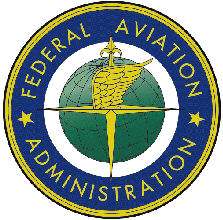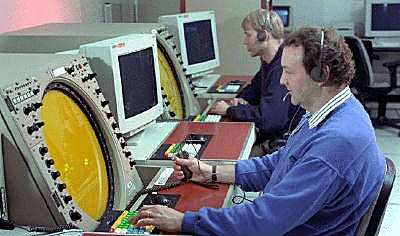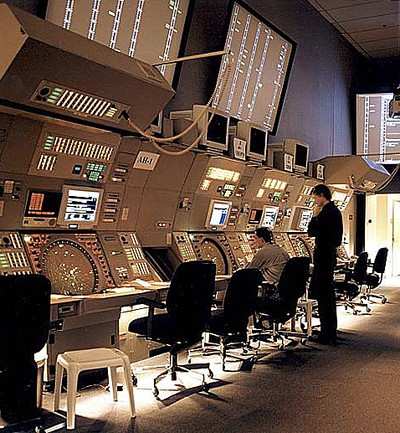Administration Report Disputes Union Allegations
 A 60-day on-site FAA investigation
of the New York Terminal Radar Approach Control (TRACON) facility
found that it is more than adequately staffed for safe operations
and that local union-controlled scheduling practices are
inefficient and wasteful, creating overtime costs that are more
than double any other air traffic control facility in the country.
The investigation also found recent management attempts to curb
wasteful practices were met with resistance, followed by anonymous
reports of "operational errors."
A 60-day on-site FAA investigation
of the New York Terminal Radar Approach Control (TRACON) facility
found that it is more than adequately staffed for safe operations
and that local union-controlled scheduling practices are
inefficient and wasteful, creating overtime costs that are more
than double any other air traffic control facility in the country.
The investigation also found recent management attempts to curb
wasteful practices were met with resistance, followed by anonymous
reports of "operational errors."
As a result of the investigation's findings, the FAA is
immediately acting to curb scheduling abuses that drive excessive
overtime spending, address reports of intimidation and
insubordination, and ensure controllers' adherence to existing high
safety standards.
"The New York TRACON has more than enough staff to get the job
done safely" said FAA Administrator Marion Blakey. "A schedule that
is designed to maximize overtime pay is no schedule at all. The
next step is for management to regain control of the daily work
schedule and use overtime when traffic requires it."
On March 2, the FAA assembled a team of over 25 safety experts
from around the country, including current and former air traffic
controllers, current field supervisors, and human resource and
organizational professionals to conduct an onsite operational
assessment of the New York TRACON.
The team conducted a thorough audit of radar and voice data,
facility scheduling practices, shift assignments, controller
time-on-position, and overtime and leave usage. The team's audit
also consisted of dozens of interviews with managers, supervisors,
and employees and first-hand observation of control room
operations.
The investigation showed conclusively that the shift scheduling
of air traffic controllers – set through a series of
agreements with local National Air Traffic Controllers Association
officials beginning nearly 15 years ago -– has not met the
facility's operational requirements and in fact necessitates much
of the scheduled overtime. The need for overtime was
compounded, the report found, by absences due to widespread abuse
of sick leave and workers compensation claims for stress routinely
filed by some controllers.

As a result, the New York TRACON, which handles fewer flights
with more controllers than most large TRACONs around the country,
incurred overtime costs of over $4 million in 2004 – more
than double that of TRACONs in Chicago, Southern California,
Atlanta and Denver combined. Generous amounts of overtime allowed
21 controllers to earn more than $200,000 last year, not including
benefits; this year, that number is projected to increase to
51. Many controllers logged overtime during weeks in which
they also called in sick one or more days, resulting in
six-and-a-half days' pay for five days of work, the study
found.
The findings come after the FAA took steps to reduce NY TRACON
overtime in response to a 2004 report by the US Department of
Transportation's Inspector General that found facility employees
were manipulating the work schedule and using sick leave and annual
leave to inflate overtime payments.
In 2004, the facility acted to reduce the availability of
voluntarily-worked "credit hours," and in January 2005, management
placed strict controls on overtime usage by controllers and
supervisors. Just eight days later, the report said, the FAA began
receiving anonymous hotline reports of operational errors. Local
NATCA officials also publicly claimed at the time that facility
understaffing was jeopardizing safety and launched a campaign to
remove the acting manager at the facility – who was taking
steps to curb overtime abuse.
The facts and data compiled by the special FAA evaluation team
found the New York TRACON has the available staffing necessary to
support safe operations and that none of the 160 operational errors
– or loss of aircraft separation – reported or
uncovered by the team posed any known risk of collision or required
the pilot to take action or report a near miss. The operational
errors that were classified as most serious under the agency's
standards were attributable to performance problems by individual
controllers, not staffing levels, the report found.
The report found no evidence of controller fatigue behind those
operational errors that were detected; instead, the investigation
concluded that controllers at the facility on average worked only 3
hours and 39 minutes a day managing traffic, the lowest of any
major TRACON facility.

Many of the operational errors detected were technical
violations of the separation standards on final approach, known as
"compression errors," that occur when the separation between
aircraft lined up for landing is briefly and minimally reduced as
aircraft slow down as they approach the airport. Other operational
errors included violations of the strict separation standards for
wake turbulence between large, heavy jets and smaller
aircraft. Controllers responsible for wake turbulence errors
have been retrained.
In response to the team's findings and recommendations, the FAA
will take the following actions immediately:
- Restore management responsibility for scheduling of the
facility by canceling the agreements that gave the union de facto
control
- Appoint the acting manager as permanent manager at the facility
effective as of today
- Transition from an inefficient schedule that necessitates
overtime to one used by most other major facilities, which should
minimize overtime and save as much as $4 million per year
- Revamp its quality assurance program for controllers and
increase supervisor presence on the control room floor
- Curb sick leave abuse, schedule manipulation and workers'
compensation abuse
- Ensure a professional environment in the control room,
including taking action to address threats and intimidation
- Turn over all evidence of inappropriate behavior to the
Inspector General's office
The Administrator has also directed the FAA's Air Traffic
Organization and Office of Aviation Safety to develop a more
realistic separation criteria and policy on compression errors on
final approach that recognizes the balance between safety and
efficiency.
The FAA plans to keep in place for an indefinite period of time
a special team of safety and human resource specialists to: assist
current facility management to carry out these recommendations; to
monitor the facility's ongoing performance; and, to ensure safety
while these stronger management controls are being implemented.
 ANN's Daily Aero-Linx (04.30.25)
ANN's Daily Aero-Linx (04.30.25) ANN FAQ: Turn On Post Notifications
ANN FAQ: Turn On Post Notifications Classic Aero-TV: Agile Aeros Jeff Greason--Disruptive Aerospace Innovations
Classic Aero-TV: Agile Aeros Jeff Greason--Disruptive Aerospace Innovations Aero-News: Quote of the Day (04.30.25)
Aero-News: Quote of the Day (04.30.25) ANN's Daily Aero-Term (04.30.25): Expedite
ANN's Daily Aero-Term (04.30.25): Expedite





